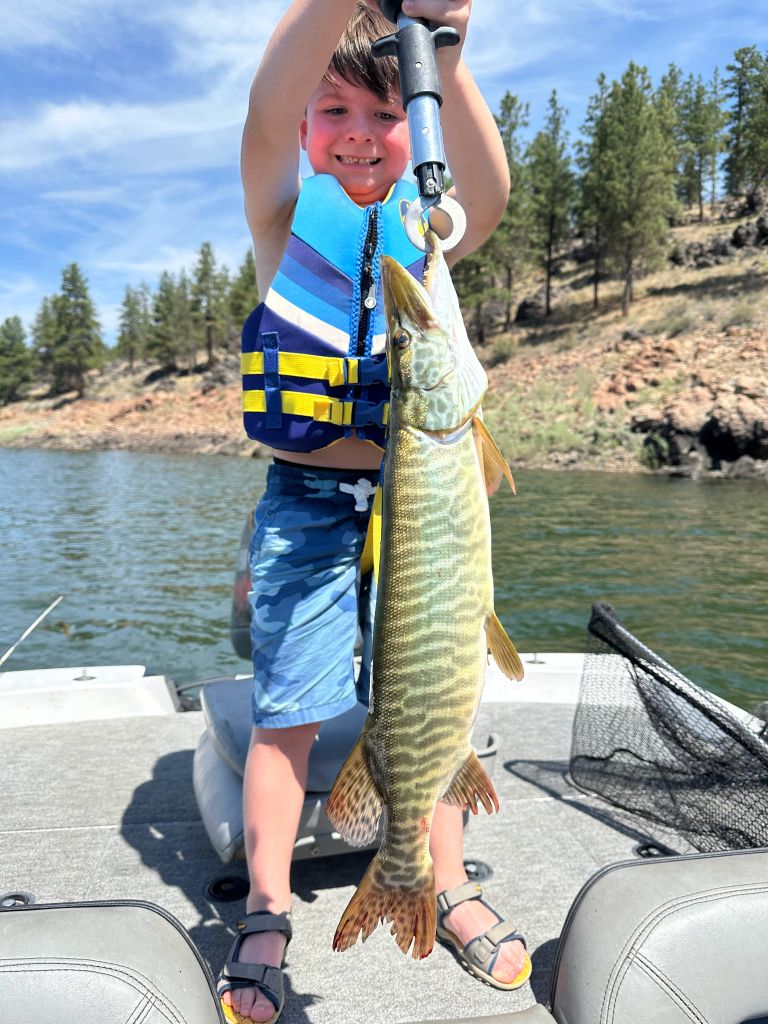6-year-old angler lands a rare trophy at Phillips Reservoir near Baker City
Published 2:54 pm Monday, August 4, 2025

- Grayson Horn, 6, of Cove, landed this trophy tiger muskie, weighing about 6 pounds, on July 30, 2025, in Phillips Reservoir near Baker City. (Contributed Photo)
Grayson Horn had secured a promise for ice cream, no small matter for a 6-year-old, but he had to cast the rubber worm just once more into Phillips Reservoir.
His choice yielded a memory sure to outlast even the sweetest of frigid treats.
Besides which, Grayson ended up with two ice creams.
Trending
More about that later.
Horn, who lives in Cove, was fishing with his dad, Sterling, on the afternoon of July 30.
It was hot that day.
After six hours on the reservoir, about 17 miles southwest of Baker City, and having caught just a pair of 6-inch smallmouth bass, father and son were ready to stalk less persnickety prey in an ice-fringed cooler.
“It was a terrible day of fishing,” Sterling said on Monday, Aug. 4.
And then it was the opposite.
Trending
Grayson readily agreed to the ice cream plan.
But he insisted on making a last cast.
Grayson recently graduated from his Minecraft-themed kids pole to a full-sized rod, and he takes angling seriously.
“He’s been in it to win it,” Sterling said with a chuckle.
Sterling suggested his son cast toward a rock near the reservoir’s north shore.
But the bail didn’t click shut and the result was a snarl of monofilament.
That seemed to Sterling an ideal reason to store the gear for the day.
Grayson disagreed.
He had negotiated one last cast, and he was determined to have it.
“He told me to turn the boat around” so he could toss the purple Senko worm toward the rock his dad had pointed to.
This cast — the actual last cast — flew true.
Then Grayson hollered.
“Dad, I’ve got a big fish.”
Sterling, on seeing the rod bent into a graceful arc, was not so much skeptical as disbelieving.
“No you don’t,” he told his son. “You’re snagged on the bottom.”
Then Sterling took the pole from his son’s hands.
A snagged hook doesn’t vibrate that way.
Grayson was right.
The fish, as yet unseen, started peeling line, making the reel spin like a top.
Then the fish leaped, droplets twinkling against the blue summer sky.
Sterling netted the fish.
He doubted at first what he knew he was seeing.
The slender fish, more than 2 feet long with distinct vertical stripes and dagger-like teeth, was a tiger muskie.
Sterling knew there were tiger muskies in Phillips.
But he couldn’t conceive that his son had just hooked a big muskie on a worm that’s supposed to entice a smallmouth bass.
“About the dumbest thing you could throw out for a tiger muskie,” Sterling said.
He took several photographs of Grayson holding the trophy, which was not a whole lot shorter than the angler.
Sterling was trying to weigh the muskie when it slithered away, taking the $40 scale into the depths.
Not that he minded.
He said he would gladly trade any scale for his son’s smile.
(Anyway, fishing for tiger muskies is catch and release only.)
Sterling said the scale, when it briefly settled between the muskie’s thrashings, was reading between 5 and 6 pounds.
An experienced bass angler, he said that seemed about right for the fish as he hefted it in the net.
Grayson, meanwhile, was engaging in one of the angler’s favorite pastimes.
Gloating.
“He kept saying, ‘I told you, Dad, one more cast.’”
Sterling said that during the tussle with the muskie, another angler drifted past in his boat. The fisherman told Sterling he was from the upper Midwest, where the lakes hold big fish such as pike and muskies. The angler told Sterling that he knows people who have fished for decades and never hooked a trophy to match Grayson’s.
Grayson wasn’t quite finished leveraging his catch.
“I think I deserve two ice creams, Dad,” he said.
He got them.
A fish biologist’s reaction
Ethan Brandt wasn’t surprised to hear that Grayson caught a tiger muskie.
But Brandt was shocked at the fish’s size.
Brandt is the district fish biologist at the Oregon Department of Fish and Wildlife’s regional office in La Grande.
Last spring, Brandt oversaw that start of a campaign designed to pare the population of yellow perch in the 2,235-acre reservoir. Since someone illegally released perch in Phillips more than 30 years ago — the culprit remains unknown — their prodigious procreation has allowed perch to replace hatchery rainbow trout as the reservoir’s predominant game fish.
Perch have outcompeted trout for food, Brandt said.
With so many fish competing for limited nutrients, the average size of perch is relatively small, with many adult fish 6 inches or less, he said. Reducing the perch population likely would boost the average size, something anglers should appreciate, he said.
ODFW still stocks thousands of hatchery rainbows in the reservoir each year, but far fewer than before the perch predominated.
The number of angler visits at the reservoir has dropped by about 90% compared to the pre-perch period.
Because ODFW isn’t proposing to poison the reservoir — the only method that could conceivably eliminate perch, Brandt said — the goal instead is to restore a species balance that yields better opportunities for anglers, whether they prefer to hook perch or trout.
ODFW officials picked tiger muskies, a hybrid of the northern pike and the muskie, as a potential, albeit partial, solution, more than a decade ago. Biologists figured tiger muskies, which are sterile, might live long enough that their voracious appetite for other fish — including perch — would result in fewer, but bigger, perch, while also helping trout to grow faster.
Starting in 2013, and continuing for the next four years, the agency dumped 53,000 juvenile tiger muskies in the reservoir.
But the experiment didn’t help much, Brandt said.
Many of the fish, which were about 5 inches long when released, were eaten by birds, Brandt said.
He said diving birds including terns, loons and mergansers, along with ospreys and other raptors, all feed on fish.
“These stockings were discontinued when it became clear that few of the fish were surviving,” according to an ODFW press release.
Brandt said some of the juvenile tiger muskies had radio trackers attached to a fin. More than half were eaten within a week or so, he said.
The 70,000 tiger muskies released on April 23, 2024, by contrast, were much smaller. About 10,000 of the 70,000 were around an inch and a half long, with the rest just three-quarters of an inch or so.
Although larger fish, as well as birds, no doubt gobbled some of the minuscule tiger muskies, Brandt said, ODFW tried to give the baby fish a boost by distributing them throughout the reservoir, but focusing on shoreline areas where copious grass should give the fish places to hide from predators.
“We are hoping to overcome the survival bottleneck we have observed in the past and that these fish will be smarter at staying away from the surface of the water where birds can pick them off,” Brandt said in 2024.
The fish were raised in a hatchery operated by the Utah Division of Wildlife Resources, which gave Oregon the fish for free.
Brandt said Utah has successfully stocked tiger muskie larvae in reservoirs in that state to control populations of other species. Tiger muskie survival rates were as high as 10% in some reservoirs, he said — far above the goal he has for Phillips.
Brandt said ODFW workers will survey the reservoir this year and in the future, including netting fish and stunning them with pulses of electricity, so they have a better sense of the distribution of species.
The tiger muskie Grayson caught on July 30 must have been one of the 70,000 fish released 15 months earlier, Brandt said on Monday, Aug. 4.
Any muskies surviving from the 2013-17 stocking would be bigger, he said.
Brandt said he didn’t think the tiny tiger muskies dumped into the reservoir last April could have grown so rapidly, to put on 23 inches or so in less than a year and a half.
Grayson’s trophy wasn’t the first indication, though, that the tiger muskies were thriving in Phillips.
During a survey in the reservoir on July 30, 2024 — coincidentally, exactly a year before Grayson’s milestone last cast — Brandt netted two tiger muskies that were nearly a foot long. That meant they had grown by 10 inches or so in just three months.
“That seems like an unusual growth rate,” he said in August 2024. “They looked healthy.”
The future for tiger muskies
Brandt had hoped to release thousands more tiny tiger muskies in Phillips this spring, but a problem with a Utah hatchery prevented that.
He’s optimistic that Utah will be able to donate more muskies in 2026, however.









